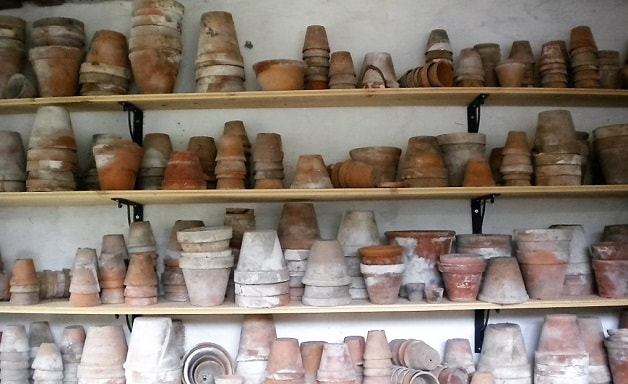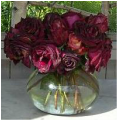70 Gardening tips
|
1. Quality
Invest in good top soil. Plants and gardening tools of best quality. It pays in the long run. Let the garden be a hobby that costs. 2. Garden Large gardens need more plants of same sort. Your garden will be less cluttered. 3. Buying plants Buy at least three plants of same variety. Plant closely in groups instead of individually. 4. The pit Dig a square hole instead of a round one by planting trees and scrubs. Theirs roots branch off easier. 5. Planting Instead of digging cover the ground with newspappers. Then put the top soil on. The newspappers will be composed. 6. Phytosanitary Use newspappers to protect your plants from cold weather. 7. Soil improvement Cut down old whitered perennials directly into the flowerbeds. 8. The compost heap Use old torn newspapers to dry up the compost if it is too wet. 9. Watering Water your garden in the evening or when it is raining so that the water soaks into the soil. Never in the sun. Otherwise the leaves will get burned. 10. Old shrubs Old shrubs will become nice and tight if you prune all the branches at least four inches above the ground. 11. The lawn Spike your lawn with a dung fork to improve the drainage. Your golf shoes with pikes are also welcome. 12. Clippings After mowing the lawn let the clippings remain to fertilize the lawn. 13. Weeds Fresh grass clippings between plants nourishes and prevents weeds to sprout. It keeps the soil moist during sunny days. 14. Fertilizer Mix 1 kg nettles with 10 liters of water. Let it be for one week. Mix one part of nettle water with nine parts of water. Fertilize both vegetables and plants. 15. Ivy The ivy will be fertilized with coffee grounds and become lush and beautiful. 16. Dead trees Dead trees can become climbing frames for roses and climbers. 17. Old things Use old things as support for climbers. For example ladders, old bicycles, chairs etc. 18. Rose planting For better flowering add some banana peels into the pit when you plant roses. Organic. 19. Weeds. Use boiling hot water or white vinegar to kill weeds between the pavings. 20. Weeds Mulch the weeds with old newspappers. They act as a ground cloth. The newspapers will decompose after some time. 21. Old branches Use old branches as plant support. 22. Seeding Spice seeds are brilliant to sow in old tins. Do not forget to make holes in the bottom before filling with top soil. 23.- Sowing and planting Empty toilet rolls are excellent pots for sowing. After sowing you can plant the rolls directly into the flower bed. 24. Seeds To keep seeds dry and protected store them in tin cans. 25. Flowers easily to sow Larkspur, daisy, columbine and purple coneflower. 26. Vermiculite Mix vermiculite in the top soil. It will become airy and well drained. 27. Aphids Spray cold water with a hard jet. Organic. 28. Blight Bicarbonate or baking soda mixed with soapy water can be sprayed on your plants. Organic. 29. Ants Sprinkle cinnamon against invasions of ants. It works both indoors and outdoors. Organic. 30. Insect protection Insects refuse cucumber, squash and corn if you put foil around. The light interferes the insects. 31. Spanish slug Spanish slugs do not like snapdragon, lady´s mantle, columbine, marigold or pion. 32. Recipe against Spanish slugs Crash three cloves of garlic in a bucket. Add 1 liter of boiling water and cook for three minutes. Allow it to cool. Strain through a coffee filter. Mix 2 tablespoons with 10 liters of water and spray on plants. Organic. 33. Venisons Old CDs set in trees and scrubs act as scarecrows. 34. Young fruit trees Protect the crown on young fruit trees Use nets against venisons. 35. Daffodils Venisons do not like daffodils. 36. Venisons Cut out hearts from white styrofoam and put them on sticks to scare the vensions. 37. Bird candy Birds love tallow, coconut oil, hemp, sunflowers, seeds, oats, hazelnuts and unsalted peanuts. 38. Lamp A common construction lamp from the store gives a good task lightning in your garden. 39.Water hose out of order A hole in your water hose can be repaired temporarily with a chewing gum or a toothpick. 40. Downpipes Let a rough chain lead rainwater vertically from the roof to the ground instead of downpipes. 41. Crane Put vaseline on the taps before closing for winter so they do not rust. 42. Dirt After gardening dirty hands can be rubbed with sugar before washing. 43. Baking The bread roller in the fridge facilitates summer baking. The dough comes away easily. 44. Energy Let your garden be an oasis where you can become mentally stimulating. 45. Romance In the romantic garden there are lush trees and bushes, moss, ground cover plants, winding paths, bird baths, clay pots, wicker chairs, trellises, birds and butterflies. 46. More space You can stammer up trees and large shrubs and get more space to furnish and plant underneath. 47. City bees Honey from city bees is not dangerous to eat. 48. Bumble bees A single bumble bee can pollinate 2.000 flowers a day. 49. Bees The apple harvest will increase 80 % if bees are nearby. 50. Bees Bees are very important for pollination.Your apples get larger with lots of bees in your garden. 51 Garden furnitures Paint your garden furnitures with linseed oil. The color lasts longer and does not flake. Organic. 52. Large pots Large pots can be filled with leaves in the bottom not to be so heavy. 53. Mini greenhouse Put plastic bottles without cork and bottom as cloches above seeding. 54. Hole in the water hose Cut off the damaged piece and splice with a new coupling kit. 55. Dry summer If the summer is dry put large barrels below the pots outdoors so that excess water does not run away. 56. Watering Water plants at the base and not on top of the leaves so that water reaches the roots. 57. Planting Plant in the evening or on a cloudy day. Otherwise the plants will get shocked in the blazing sun. 58. Tomatoes Avoid planting your potatoes near tomato plants if you want to avoid leaf mold spores. 59. Divide perennials When flowering is reduced and the plant gets thin it is time to divide the plant. It will grow young again and you get more plants. Every fifth years may just be right for most perennials. 60. Soil depth Soil depth should be at least 60 cm for trees and bushes. In flower beds and vegetable gardens at least 40 cm deep. 61. Edge support Thick stems and branches can serve as edge support. 62. Flower beds Well drained top soil and raised flower beds help to improve growth. 63. Bark mull Bark mull is better than bark which consumes a lot of oxygen when it decomposes. 64. Ground cover Ground cloth, newspapers, black plastic or gravel are suitable as ground cover. 65. Rotary cultivator Rotary cultivator spreads more weeds. 66. Open compost heap Open compost heap attracts Spanish slugs. 67. Chicken manure water Mix 1 litre of chicken manure with 10 litres of water. Ready to use after two days. Dilute with water until the color looks like tea. 68. Dung fork Dung fork is easier to handle than a spade when you part or transplant perennials. 69. Trowel Dig against you with your trowel. On the contrary the digging strains on your wrist. 70. Bird´s bath A large pot dish or a soup plate can be used as a bird´s bath in your garden. |
|
© Copyrights: Allotmentphotogallery.com - Swedish garden cottages 2012-2024. Email: [email protected] |


